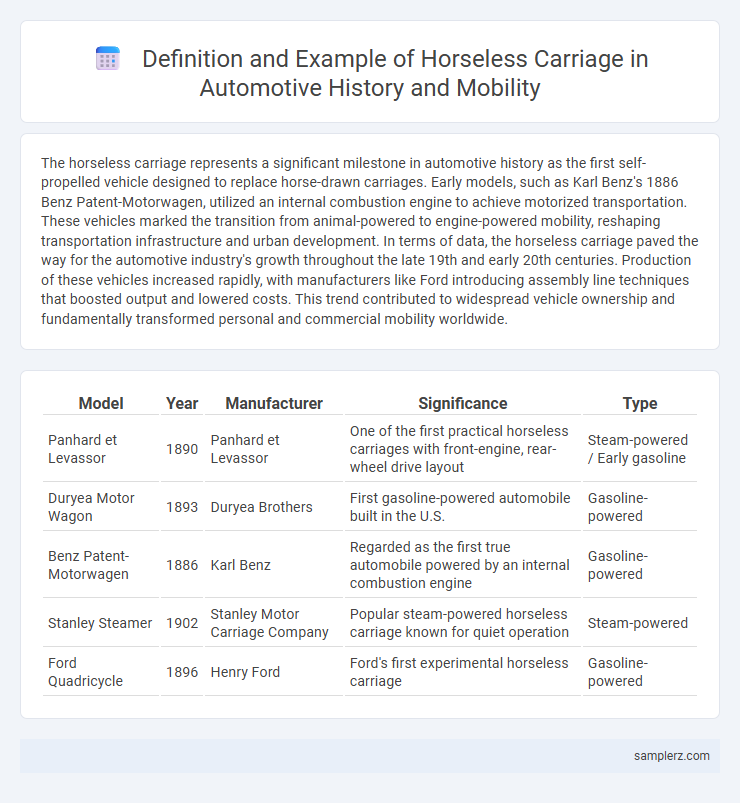The horseless carriage represents a significant milestone in automotive history as the first self-propelled vehicle designed to replace horse-drawn carriages. Early models, such as Karl Benz's 1886 Benz Patent-Motorwagen, utilized an internal combustion engine to achieve motorized transportation. These vehicles marked the transition from animal-powered to engine-powered mobility, reshaping transportation infrastructure and urban development. In terms of data, the horseless carriage paved the way for the automotive industry's growth throughout the late 19th and early 20th centuries. Production of these vehicles increased rapidly, with manufacturers like Ford introducing assembly line techniques that boosted output and lowered costs. This trend contributed to widespread vehicle ownership and fundamentally transformed personal and commercial mobility worldwide.
Table of Comparison
| Model | Year | Manufacturer | Significance | Type |
|---|---|---|---|---|
| Panhard et Levassor | 1890 | Panhard et Levassor | One of the first practical horseless carriages with front-engine, rear-wheel drive layout | Steam-powered / Early gasoline |
| Duryea Motor Wagon | 1893 | Duryea Brothers | First gasoline-powered automobile built in the U.S. | Gasoline-powered |
| Benz Patent-Motorwagen | 1886 | Karl Benz | Regarded as the first true automobile powered by an internal combustion engine | Gasoline-powered |
| Stanley Steamer | 1902 | Stanley Motor Carriage Company | Popular steam-powered horseless carriage known for quiet operation | Steam-powered |
| Ford Quadricycle | 1896 | Henry Ford | Ford's first experimental horseless carriage | Gasoline-powered |
The Dawn of the Horseless Carriage Era
The dawn of the horseless carriage era marked a transformative phase in automotive history, symbolized by Karl Benz's 1886 Patent-Motorwagen, the first true automobile powered by an internal combustion engine. This innovation replaced horse-drawn carriages with self-propelled vehicles, introducing unprecedented mobility and laying the foundation for modern automotive engineering. Early horseless carriages utilized lightweight designs and gasoline engines, setting the stage for rapid advancements in transportation technology.
Key Innovators Behind Early Automobiles
Karl Benz, widely recognized for inventing the first practical horseless carriage in 1885, pioneered the internal combustion engine that revolutionized automotive mobility. Alongside Benz, innovators like Gottlieb Daimler and Wilhelm Maybach advanced lightweight engines and chassis designs, setting foundational standards for modern vehicles. Their breakthroughs sparked the evolution of personal transportation, transforming horseless carriages into efficient, reliable automobiles.
Benz Patent-Motorwagen: The First True Horseless Carriage
The Benz Patent-Motorwagen, patented in 1886 by Karl Benz, is widely recognized as the first true horseless carriage, marking a pivotal milestone in automotive history. Powered by a single-cylinder four-stroke engine producing 0.75 horsepower, this three-wheeled vehicle demonstrated the viability of motorized transport without horse power. Its innovative design set the foundation for modern automobiles, influencing mobility by transitioning from animal-based to engine-driven transportation.
Steam-Powered Vehicles: Pioneers of Mobility
Steam-powered vehicles, such as the 18th-century Cugnot steam wagon, represent the earliest horseless carriages and played a pivotal role in automotive history by demonstrating the feasibility of self-propelled transport. These pioneers of mobility utilized steam engines to replace horse-drawn carriages, laying foundational technology for future internal combustion engines. Their innovation catalyzed developments in automotive engineering and established mobility as a key driver of industrial progress.
The Role of Electric Horseless Carriages in Early Transportation
Electric horseless carriages played a pivotal role in early automotive history by providing a clean, quiet, and efficient alternative to steam and gasoline-powered vehicles. Companies like Baker Electric and Detroit Electric pioneered battery technology, enabling urban transportation with zero emissions decades before modern electric cars became mainstream. These early electric vehicles demonstrated the feasibility of electric propulsion, influencing the development of sustainable mobility solutions in the 20th and 21st centuries.
Impact of the Duryea Motor Wagon on American Roads
The Duryea Motor Wagon, introduced in 1893, marked a pivotal shift in American transportation by demonstrating the practical viability of gasoline-powered vehicles. It spurred the growth of early automotive manufacturing, leading to improved road infrastructure designed to accommodate motor vehicles. This innovation accelerated the transition from horse-drawn carriages to motorized transportation, fundamentally transforming urban and rural mobility across the United States.
Transition from Carriages to Automobiles
The transition from carriages to automobiles marked a pivotal shift in mobility, as early horseless carriages replaced horse-drawn vehicles with steam, electric, and gasoline engines. Innovations like Karl Benz's 1886 Patent-Motorwagen introduced practical internal combustion engines, drastically improving speed, range, and reliability compared to traditional carriages. This breakthrough laid the foundation for modern automotive design, sparking widespread adoption and transforming transportation infrastructure worldwide.
The Rise of Gasoline Engines in Horseless Carriages
The rise of gasoline engines in horseless carriages revolutionized automotive history by replacing steam and electric power with a more efficient and powerful technology. Pioneered by inventors like Karl Benz in the late 19th century, gasoline engines enabled longer travel distances and faster speeds, accelerating the adoption of motor vehicles. This innovation laid the foundation for the modern internal combustion engine, driving the evolution of mobility and transportation worldwide.
Influence of Horseless Carriages on Urban Mobility
Horseless carriages revolutionized urban mobility by introducing motorized transportation that replaced horse-drawn vehicles, significantly increasing travel speed and efficiency within cities. This innovation prompted the development of better road infrastructures and expanded urban layouts to accommodate faster, more reliable transit. The shift to horseless carriages also catalyzed the growth of suburbs, enabling people to live farther from city centers while maintaining accessible commutes.
Legacy of the Horseless Carriage in Modern Automotive Design
The legacy of the horseless carriage is evident in modern automotive design through its pioneering integration of engine technology and chassis development, setting foundational principles for vehicle structure and propulsion. Early innovations in steering mechanisms and suspension systems from horseless carriages directly influenced contemporary safety and handling features. This historical foundation continues to inspire advancements in electric and autonomous vehicle designs, maintaining a link between past engineering breakthroughs and future mobility solutions.

example of horseless carriage in automotive history Infographic
 samplerz.com
samplerz.com